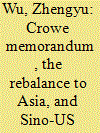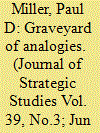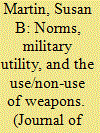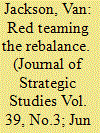|
|
|
Sort Order |
|
|
|
Items / Page
|
|
|
|
|
|
|
| Srl | Item |
| 1 |
ID:
146234


|
|
|
|
|
| Summary/Abstract |
Many contemporary academics and policy analysts have revisited the Anglo-German rivalry before 1914 to predict what may await China and the United States in the twenty-first century. However, few, if indeed any, have specified in what sense this comparison can be made. This paper attempts to fill this gap with a detailed analysis of the strategic parallels between the Anglo-German rivalry then and the China–US competition now through the lens of the Crowe Memorandum. The author argues that the basic parallel between the rise of Germany and the rise of China lies in the challenges they posed or pose to the dominant maritime power and system leader – Great Britain then and the United States today. This parallel also explains the similarity between the Triple Entente initiated by Great Britain prior to 1914 and the Rebalance to Asia launched by the United States in 2011. Furthermore, as in the case of the Anglo-German rivalry before 1914, the most crucial problem underlying the mounting China–US competition in recent years has been America’s deepening apprehension about the development of China’s anti-access/area-denial (A2/AD) and naval capabilities. This development, from the US perspective, is threatening to deprive the US of its most crucial instrument to influence the strategic equilibrium on the East Asian littorals. Based on the lessons of the Anglo-German rivalry prior to 1914, the essay also examines the potential for mitigating, if not eliminating, the mounting competition and misgivings between China and the United States.
|
|
|
|
|
|
|
|
|
|
|
|
|
|
|
|
| 2 |
ID:
146236


|
|
|
|
|
| Summary/Abstract |
Decades of scholarship have warned against using historical analogies for policymaking. But the Taliban insurgency appears, on the surface, to confirm the usefulness of historical analogies to the British and Soviet wars in Afghanistan. I review the use of analogies for the war in Afghanistan and argue the analogies were historically unsound and strategically unhelpful. In fact, their effect on policy helped create the conditions for the very insurgency policymakers most hoped to avoid. The Taliban insurgency did not occur because of the presence of too many foreign troops and aid workers, but because there were too few.
|
|
|
|
|
|
|
|
|
|
|
|
|
|
|
|
| 3 |
ID:
146232


|
|
|
|
|
| Summary/Abstract |
The role of norms and military utility in the use of weapons is disputed by constructivist and realist scholars. Through an examination of US decision-making regarding anti-plant and irritant agents in the Vietnam War, I advance this debate in three key ways. First, I develop structural realism’s expectations regarding the role of military utility. Second, I demonstrate that social and material factors are at play in our understandings of both ‘norms’ and ‘military utility’, and that both played a role in US decisions. Third, I find that the dominant role – as structural realism expects – was played by military utility.
|
|
|
|
|
|
|
|
|
|
|
|
|
|
|
|
| 4 |
ID:
146233


|
|
|
|
|
| Summary/Abstract |
What specific forms of reasoning underlie the US approach to Asia, what downside risks do they imply, and to what extent can they be mitigated? This article examines the theoretical underpinnings of the US “rebalance” to Asia by categorizing US policies according to three types of logic: military power; economic liberalism; and institutionalism. It then uses international relations theory as a diagnostic tool to assess risks in these approaches. Recent efforts toward improving transparency in contested maritime areas and capacity-building of local allies and partners may address the strategy’s most acute risks, while inevitably generating more in the process.
|
|
|
|
|
|
|
|
|
|
|
|
|
|
|
|
| 5 |
ID:
146235


|
|
|
|
|
| Summary/Abstract |
Over the last two decades, a number of countries (most notably China, Russia and Iran) have been developing so-called anti-access and area denial (A2/AD) capabilities, such as ballistic and cruise missiles, offensive cyber-weapons, electronic warfare, etc. The development of A2/AD capabilities by non-Western countries undermines the foundations of US power projection and global military-technological supremacy. In order to overcome, or at least mitigate, the impending A2/AD challenge, the US Department of Defense (DoD) began to roll out its so-called ‘third’ offset strategy in late 2014. The strategy aims to bring about innovative operational concepts and technologies and spur new doctrinal and organisational debates. This article assesses which of the operational concepts and capabilities informing current US discussions on offset may be relevant in the context of the A2/AD challenges Europeans face on their eastern ‘flank‘ and in their ‘extended southern neighbourhood‘, and which may not. Europeans must grapple with the same conceptual puzzle as the US: how to strike the right balance between defeating A2/AD capabilities and hedging against them, i.e. through alternative strategies that are less dependent on unhindered access and resort to asymmetric forms of warfare. However, they must take into account the geographical features of their eastern flank and extended southern neighbourhood, the level of technological maturity of their challengers, and their own military-technological prowess and political limitations. This suggests a somewhat different approach to offsetting A2/AD than that adopted by the US.
|
|
|
|
|
|
|
|
|
|
|
|
|
|
|
|
|
|
|
|
|